It’s Not Just For The Big Corporations With Science Labs!
Congress created the research and development tax credit in 1981 as a temporary tax incentive for companies who were conducting research and developing new products and services. Referred to as the R&D tax credit, this temporary tax credit was allowed to expire 16 times over the years before being made a permanent tax credit effective as of January 1st 2015. This was definitely good news and it was made even sweeter when Congress made some additional improvements to the credit that opened the door for smaller companies.
The R&D tax credit is a dollar-for-dollar reduction of tax liability and, previously was only allowed to be used to offset regular income tax. Now, as of January 1st, 2016, eligible small businesses can also use the credit to offset alternative minimum tax. For the record, an eligible small business is defined as a business with less than $50 million in average gross receipts for the 3 preceding years.
Congress also decided that if you’re a qualified small business, you can use the R&D credit to offset your employer FICA match for up to $250,000 a year. A qualified small business is defined as having less than $5 million in annual gross receipts and having gross receipts for no more than 5 years. This means that newer businesses can potentially benefit from the credit before generating taxable profits.
You might be wondering if any of your business activities qualify for the credit. Typically a company that is engaged in activities that create or improve a product, technique, process, invention or formula is a possible candidate for the credit. Are you conducting research, creating software applications, modifying existing processes or systems or testing out new materials and concepts? Maybe you’re designing and testing prototypes or product alternatives, creating new designs or developing new manufacturing processes. If you’re engaged in any of these types of activities, you just might qualify.
Expenses that qualify for the R&D tax credit include wages paid to both owners and employees performing a qualified service as well as supplies that are directly attributable to the qualified research activities. If you contract your research activities out, you may be able to claim up to 65% of these expenses as well.
As with most, if not all tax deductions and credits, the IRS does require certain documentation to substantiate the R&D credit. There are 2 methods available when documenting your qualified research activities; the project approach and the departmental approach.
The project approach requires detailed time tracking throughout your project and the departmental approach uses various sources of information to develop a time estimate. The R&D Tax Credit and other related tax breaks save U.S. businesses more than $12 billion annually. If you’re engaged in any activities that you think might qualify, it’s worth taking a closer look at the R& D Credit.
If you have questions about this or other tax and accounting topics, send me an email or visit my website.
Read Are You Eligible for the Research and Development Credit? and the other informative articles in this issue of Soar to Success magazine.









